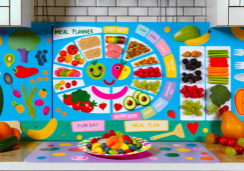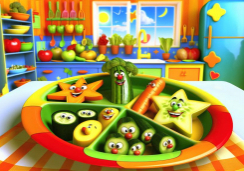Winning Meal Strategies for Picky Eaters
In the grand culinary coliseum, you've surely bested the pickiest of eaters with your infallible arsenal of chicken nuggets and macaroni art. Yet, you're aware that the true victory lies not in the momentary ceasefire but in devising a strategy that'll encourage a truce between tiny taste buds and the rich tapestry of nutritious cuisine.
As a seasoned campaigner in the kitchen, you recognize the importance of not labeling the dietary preferences of your mini connoisseurs, nor leaving a breadcrumb trail of snacks that lead them astray. You've learned to bypass mealtime skirmishes altogether, offering dishes that are both wholesome and appealing, without ever resorting to the classic 'eat this or go to bed' ultimatum.
To transform these selective eaters into adventurous food critics, you'll need to employ tactics that are both shrewd and subtle. And perhaps, as you contemplate your next move in this epicurean chess game, you'll find that the key to unlocking their palates is simpler than you think.
Embrace the challenge, for your journey through the gastronomic jungles is about to take an unexpected turn.
Embrace Flexible Menus
To accommodate diverse palates within your household, consider adopting flexible menus that offer a variety of nutritious choices, allowing everyone to find something they enjoy while still getting the necessary nutrients. Picky eating is often a phase, but it can persist without proper intervention. Make meals less of a battle by incorporating options that cater to different preferences and gradually introduce new foods alongside familiar favorites.
Encourage your child to try small portions of new items. Offer the food repeatedly, as it can take several exposures for a child to accept a new taste. Let your child have a say during meal planning; this can ease their apprehension about certain foods. If they help make it, they're more likely to eat it.
Rotate meals and snacks to prevent boredom. Providing a balanced selection from which your child can choose promotes autonomy and may reduce resistance. Don't force them to eat everything on their plate, but do encourage them to taste everything.
Establish Pantry Rules
Establishing clear pantry rules can help ensure that everyone in the family has access to healthy food choices and understands when and how they can enjoy snacks and other items. For picky eaters, it's crucial to stock up on a wide variety of nutritious options that encourage them to try new foods without overwhelming them.
To foster healthy eating habits, make sure your pantry reflects the kind of diet you want your kids to eat. Remove temptation by replacing unhealthy snacks with healthier alternatives that provide an age-appropriate amount of nutrients. This not only reduces mealtime battles but also supports kids in making better food choices, especially when they're refusing to eat what's on their plate.
Set specific pantry hours to limit access before meals, which can help in managing hunger and increasing openness to new foods at mealtime. By having established guidelines for how and when pantry items can be consumed, you create a structured environment that reinforces healthy behaviors.
Lastly, involve your children in the process of setting these pantry rules. This engagement can empower them to take ownership of their eating habits, making it more likely they'll adhere to the guidelines and less likely they'll resist the changes you're implementing.
Reinvent Mealtime Dynamics
Reinventing mealtime dynamics often starts with involving your child in the kitchen, a practice that can significantly increase their interest in and acceptance of different foods. When picky eaters take part in preparing meals, they're more likely to try new foods that they've had a hand in making. Remember, it's about building healthy eating habits, not winning power struggles.
Here are a few strategies to consider:
- Start Small: Offer bite-sized portions of new foods to avoid overwhelming your child. Gradually increase the size as they become more comfortable.
- Be Patient: It can take several attempts before a child accepts a new food. Don't give up too quickly; persistence pays off.
- Avoid Pressure: Don't force your child to eat. Encourage them to listen to their bodies and respect their hunger cues.
Assign your child an age-appropriate task, such as washing vegetables or mixing ingredients. This builds trust and transparency about what goes into their meals. By offering a variety of foods each day and involving them in the process, you're not only reinventing mealtime dynamics but also setting the stage for your child to develop a lifelong appreciation for diverse, nutritious foods.
Introduce Diverse Flavors
Introducing your picky eater to a variety of flavors can often spark their interest and lead to a more adventurous palate. Gradually experiment with different herbs, spices, and seasonings to add excitement to meals. This can make healthy foods more appealing and is a smart strategy to foster child healthy eating habits. Remember, it's about offering the food in a way that's enticing and fun.
Incorporating global cuisines exposes your child to diverse flavors and broadens their culinary horizons. These new experiences can transform mealtime from a battle of wills into an exploration of world cultures. The key is to introduce these foods one at a time and not overwhelm your picky eater. Always aim for at least one familiar item on the plate to provide comfort and a bridge to try new things.
Engage your child in meal preparation, which can pique their curiosity. Whether it's choosing ingredients or helping to cook, involvement can lead to a willingness to taste the fruits of their labor. A children's hospital nutritionist can provide additional age-appropriate tips to diversify your child's diet. By keeping the focus on nutrient-rich foods and diverse flavors, you're laying the groundwork for a lifetime of healthy eating.
Incorporate Cooking Games
To ignite a child's enthusiasm for cooking, consider integrating cooking games that make meal prep an engaging and educational experience. Games can transform the daunting task of getting your child to eat into a fun activity that piques their curiosity. When a child is involved in making their own meals, they're more likely to try new foods and enjoy eating them.
Here are a few ideas to incorporate cooking games into your routine:
- Ingredient Bingo: Make meal prep different every time by creating a bingo card filled with various healthy ingredients. Help your child learn about each one as they find ways to include them in their dish.
- Recipe Race: Set a timer and challenge your child to complete a simple recipe. This can teach your child the importance of following steps while making cooking feel like a playful challenge.
- Shape Shifters: Use cookie cutters to turn foods into fun shapes. This not only makes the plate more appealing but also allows you to teach your child about food groups as they choose different shapes for fruits, vegetables, proteins, and whole grains.
Frequently Asked Questions
What Are the 5 P's of Picky Eating?
The 5 P's you'll need are Patient Persistence, Positive Reinforcement, Playful Presentation, Portion Control, and Palate Expansion, ensuring you're consistently applying Pressure Avoidance and Pleasure Association with Predictable Routines and Peer Modeling.
How Do You Feed an Extremely Picky Eater?
To feed an extremely picky eater, try gentle exposure and flavor graduation. Experiment with texture trials and food pairing within their comfort zone. Use creative presentation, positive reinforcement, and sensory play for hunger management and nutrient density.
How Do You Meal Prep if You're a Picky Eater?
Focus on favorable flavors and textures you enjoy. Try ingredient swaps in comfort foods, batch cooking for convenience, and creative presentations. Consider spice selections, allergy alternatives, nutrient densification, and personalized portions for your meals.
What Is the SOS Approach for Picky Eaters?
The SOS Approach for picky eaters combines sensory exploration, food chaining, and gradual introduction with texture variation, taste education, and positive reinforcement, using playful presentation in a non-pressure environment for responsive feeding with therapeutic techniques.
Conclusion
You've got this! By adopting flexible menus and setting clear pantry rules, you're steering your picky eater towards healthy habits.
Transform mealtime from a battleground to a shared adventure, and keep things exciting with a variety of flavors.
Get them involved—cooking can be a playful, learning experience.
Remember, your consistent example shapes their choices.
With patience and creativity, you're nurturing not just a love for nutritious foods but also a joyful, lifelong relationship with eating well.










